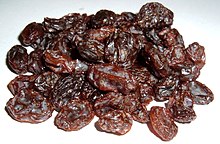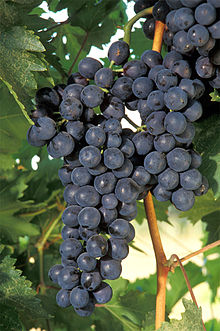Grape
![]()
The title of this article is ambiguous. For other meanings, see Grape (disambiguation).
Grapes are the fruit clusters of grapevines (Vitis), in particular those of the noble vine (Vitis vinifera subsp. vinifera). The individual fruits of the inflorescence are called grapes. Colloquially, a clear distinction is not always made between berries and grapes. From a botanical point of view, however, the shape of the fruit set with branched lateral axes is not a grape, but a panicle. In the technical language of viticulture, the inflorescences are called clusters.
The climbing plant grapevine is one of the oldest cultivated plants of mankind. Today, about 16,000 grape varieties are known. There are vines with green or yellow ("white") berries and those with red to dark blue ("red") berries. These are spherical to ovoid in shape and have a diameter of 6 to 20 millimeters.
Grapes may be eaten raw (table grapes), dried to make raisins and processed to make wine, brandy, grape juice and the like (wine grapes). Pomace - the press residue left over from winemaking - is processed into spirits in particular. A very well-known grape marc spirit is the Italian grappa.
The skin as well as the seeds of the grapes contain oligomeric proanthocyanidins (OPCs), which among other things act as strong antioxidants; the seeds can be processed into grape seed oil and grape seed flour. The seeds as well as the skin of the berries are also a source of the antioxidant resveratrol.
Seedless grapes are produced by artificially induced parthenocarpy (virgin fruiting).
Wine is produced during the manufacturing process by alcoholic fermentation. In the process, musts or mashes are produced from the grapes by stomping or pressing (winepress), which are then fermented into wine.

Dried grapes (raisins)

Grape with berries of a red grape variety

bunch of grapes of a white grape variety
Average composition
The composition of grapes varies naturally, depending on both environmental conditions (soil, climate) and cultivation techniques (fertilisation, plant protection).
Data per 100 g edible portion:
|
|
|
|
The main components dissolved in the flesh of berries are the sugars glucose and fructose, as well as tartaric and malic acid.
1 mg = 1000 µg
1 semi-essential
The physiological calorific value is 287 kJ (68 kcal) per 100 g of edible portion.
Economic importance
According to FAO, a total of 77,136,819 tons of grapes were harvested worldwide in 2019.
The following table gives an overview of the 20 largest producers of wine grapes worldwide, which produced a total of 67,104,642 tonnes, or 87.0% of the harvest volume.
| Largest wine grape producers (2019) | ||||||
| Rank | Country | Quantity |
| Rank | Country | Quantity |
| 1 | China People's Republic of | 14.283.532 | 11 | Iran | 1.945.930 | |
| 2 | Italy | 7.900.120 | 12 | Egypt | 1.626.259 | |
| 3 | United States | 6.233.270 | 13 | Uzbekistan | 1.603.308 | |
| 4 | Spain | 5.745.450 | 14 | Australia | 1.553.602 | |
| 5 | France | 5.489.650 | 15 | Brazil | 1.485.292 | |
| 6 | Turkey | 4.100.000 | 16 | Germany | 1.125.000 | |
| 7 | India | 3.041.000 | 17 | Afghanistan | 1.112.927 | |
| 8 | Chile | 2.701.588 | 18 | Romania | 973.990 | |
| 9 | Argentina | 2.519.886 | 19 | Portugal | 863.220 | |
| 10 | Sud Africa | 1.993.048 | 20 | Greece | 807.570 | |
| Top Twenty | 67.104.642 | |||||
| remaining countries | 10.032.177 | |||||
For comparison, the figures for Austria (309,920 t) and Switzerland (124,061 t).
See also:
→ Main article: Viticulture
→ Main article: Raisin
→ Main article: Grape juice
→ Main article: Table grape
→ Main article: Grape seed oil
Search within the encyclopedia